|
 |
|
Hosta kikutii
aka Hyῡga Gibōshi
|
|
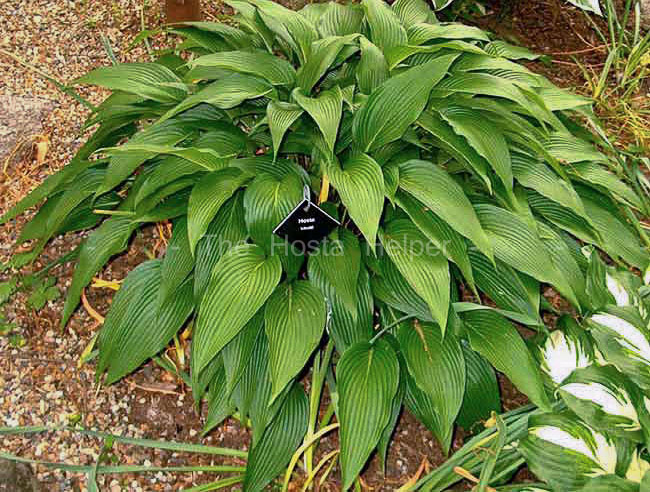 |
|
 |
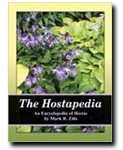
 This is a medium size (16 inches high
by 42 inches wide) medium to dark green leaved
species of hosta that originated in
Japan and was first described by
Dr. Fumio Maekawa in 1940.
It has a medium to fast growth rate compared to other species hostas. The leaves
are shiny and narrow with lightly rippled margins. It forms a "beak-like" bract
around the flower buds and bears clusters of near white flowers with purple
anthers from late August into September. They produce viable seeds. This is a medium size (16 inches high
by 42 inches wide) medium to dark green leaved
species of hosta that originated in
Japan and was first described by
Dr. Fumio Maekawa in 1940.
It has a medium to fast growth rate compared to other species hostas. The leaves
are shiny and narrow with lightly rippled margins. It forms a "beak-like" bract
around the flower buds and bears clusters of near white flowers with purple
anthers from late August into September. They produce viable seeds.
According to
The Hostapedia by Mark Zilis (2009), "It is one of the four most
common species found in
Japan,
H. montana, H. sieboldii
and
H. longipes being the others."
The Hostapedia
also says that there are four distinct forms of
H. kikutii including:
-
Species - H. kikutii
-
Forma -
H. kikutii
caput-avis
-
Forma -
H. kikutii
leuconata
-
Forma -
H. kikutii
yakusimensis
 And this species "...makes an attractive mound of shiny,
green foliage with an outstanding late-season show of lavender
flowers...several botanical forms with
H. kikutii
caput-avis and
H. kikutii
yakusimensis being the most common in hosta
collections." And this species "...makes an attractive mound of shiny,
green foliage with an outstanding late-season show of lavender
flowers...several botanical forms with
H. kikutii
caput-avis and
H. kikutii
yakusimensis being the most common in hosta
collections."
Another form is
H. kikutii tosana.
Mark Zilis' Field
Guide to Hostas (2014) states that this species
was found in Japan in "...in rocks, riverside..."
 Nomenclature changes recommended in the
1991 book The
Genus Hosta by
W. George Schmid and accepted by The American Hosta Society would update names as follows:
H. tortifrons is now H.
'Tortifrons'
and H. tardiflora is now H.
'Tardiflora'. Nomenclature changes recommended in the
1991 book The
Genus Hosta by
W. George Schmid and accepted by The American Hosta Society would update names as follows:
H. tortifrons is now H.
'Tortifrons'
and H. tardiflora is now H.
'Tardiflora'.
|
 |
| An article about Fall Bloomers by
Herb Benedict and
Jim Wilkins in
The
Hosta Journal (1991 Vol. 22 No. 1) states that, "Here
are some of the fall blooming plants we grow...(listed in the order of bloom
times in Michigan). |
| 1) H. kikutii
|
A medium size plant densely flowering
with white blooms. The flowers are equally arranged around the
central axis of the raceme so that the bloom scapes resembles a
bottle brush or pony tail...We are growing two named varieties,
'Hirao-59' and 'Finlandia'. |
| 2) H. 'Fall Bouquet' |
Small, green plant, leaves slightly
undulated, lavender scape and blooms, floriferous. |
| 3) H. longipes |
Small green plant, densely flowering
with a tall stiff bloom scape. The flowers are lavender and the
leaves are green. |
| 4) H. gracillima |
Funnel-shaped, light lavender flowers.
A miniature green plant, with shiny surface. |
| 5) H. 'Iwa' |
Iwa means rock, and this plant was
imported by Marjorie Soules, from Japan. It is a small green plant
with lavender flowers. |
| 6) H. tortifrons
|
In the same section (Picnolepis) as
H. longipes and
H. rupifraga. Distinctive small plant, with twisted
green leaves and lavender flowers. |
| 7) H. 'Fused Veins' |
Small, green leaves often with ¼ inch
margin which is a lighter green. The lance shaped leaves are
undulated and the veins come together regularly. The flowers are
mauve and the scape is sometimes branched. |
| 8) H. rupifraga |
Small, medium green, with thick,
leathery, ovate leaves. Densely flowering with purple flowers. 'Urajiro',
'Grand Slam', 'Maruba Iwa' |
| 9) H. tardiflora |
This small hosta is the last to bloom
for us. Its leaves are shiny, dark green and lance shaped. The
flowers are light lavender and borne in abundance on 12 inch scapes. |
|
| Their observations about using fall blooming hostas in hybridizing programs: |
| 1) H. tardiflora × self |
Tends to flower 2 weeks earlier. 90% of
the progeny have the flowers secund (flowers all on one side of the
bloom stalk) and in 10% they are evenly arranged around the central
axis of the raceme (nonsecund). |
| 2) H. rupifraga × H. tardiflora |
Beautiful very tough plant with a
taller bloom stalk. Blooms 2 weeks earlier. |
| 3) H. 'Maruba Iwa' × H. tardiflora |
Taller bloom stalk. Blooms 2 weeks
earlier. 30% of progeny have nonsecunded flowers. |
| 4) H. gracillima × H. tardiflora |
Very nice small plant, with leaves
intermediate between the two. Beautiful flowers. |
| 5) H. rupifraga ×
H. kikutii |
The best of this cross is called 'Roys
Pink'. It is a perfect intermediate. The leaf is long, heart shaped
and very thick. The flowers are pony tail in type, a light pinkish
color and spent flowers drop off cleanly. |
|
 |
|
|
Dr Ralph (Herb) Benedict
in
The
Hosta Journal (1992 Vol. 23 No. 1) discusses three forms
of H. kikutii brought from
Japan in
the Minnesota garden of Hideko Gowen.
H. kikutii 'Kifurkurin'
H. kikutii polyneuron 'Shirofukurin
Shikoku'
H. kikutii polyneuron 'Shirofukurin Wakayama'
 Herb wrote that "...in 1982 she obtained the yellow edged
one, H. kikutii 'Kifurkurin' - it was labeled H. kikutii 'Variegata'. 'Variegata' is
an invalid name from Mr Negishi. The plant has leaves eight inches long by four
inches wide. The leaf petiole is one and on-half to two times as long as the
leaf blade. It has a chartreuse margin about one-fourth of an inch wide and a
center which is a medium green. The bloom stalk is short and erect with a
typical bird-head shaped bud. It blooms in late August in
Michigan with
pale-lavender, wide-flared blooms....All three of these plants have wavy leaves
and variegated edges - they are jewels in any hosta lover's garden!" Herb wrote that "...in 1982 she obtained the yellow edged
one, H. kikutii 'Kifurkurin' - it was labeled H. kikutii 'Variegata'. 'Variegata' is
an invalid name from Mr Negishi. The plant has leaves eight inches long by four
inches wide. The leaf petiole is one and on-half to two times as long as the
leaf blade. It has a chartreuse margin about one-fourth of an inch wide and a
center which is a medium green. The bloom stalk is short and erect with a
typical bird-head shaped bud. It blooms in late August in
Michigan with
pale-lavender, wide-flared blooms....All three of these plants have wavy leaves
and variegated edges - they are jewels in any hosta lover's garden!"
 A piece in
The Hosta Journal (1995 Vol. 26 No. 1) citing Vol. 1, #2, Fall 1993,
Great Lakes Region Newsletter included a list of Hostas for The Hybridizer from
Jim Dishon:

 An article about favorite flowering hostas by
W. George Schmid in
The
Hosta Journal (2006 Vol. 37 No. 2) says, "The best
flowers are on H. plantaginea and its multi-petalous cousins, 'Venus'
and
'Aphrodite'...H. capitata in bud is fine, but its offspring, 'Nakaimo' has
flowers that begin with the shine of precious porcelain and stay closed in bud
longer...H. kikutii forms all have fine and late flowers, but the best are on
H. kikutii var. densa (H. densa). They are white and form a tight bunch at the top
of the scape. H. laevigata has large, spidery flowers in abundance; its cousin
H. yingeri has smaller ones with the same spidery character and dark color.
These spidery flowers are carried all around the stem unlike other hosta flowers
that, "lean to one side...Finally, mature clumps of 'Blue Angel' and 'Elegans'
have a beautiful flower display when many flowers on different scapes open in
unison..." An article about favorite flowering hostas by
W. George Schmid in
The
Hosta Journal (2006 Vol. 37 No. 2) says, "The best
flowers are on H. plantaginea and its multi-petalous cousins, 'Venus'
and
'Aphrodite'...H. capitata in bud is fine, but its offspring, 'Nakaimo' has
flowers that begin with the shine of precious porcelain and stay closed in bud
longer...H. kikutii forms all have fine and late flowers, but the best are on
H. kikutii var. densa (H. densa). They are white and form a tight bunch at the top
of the scape. H. laevigata has large, spidery flowers in abundance; its cousin
H. yingeri has smaller ones with the same spidery character and dark color.
These spidery flowers are carried all around the stem unlike other hosta flowers
that, "lean to one side...Finally, mature clumps of 'Blue Angel' and 'Elegans'
have a beautiful flower display when many flowers on different scapes open in
unison..."
|
 |
 |
|
|
"Although
variable in the wild and under
cultivation, this species has beautiful,
late flowers and mounds up well. Its
leaves are characteristically narrow
with tight veins. It does extremely well
in the south (being from Kyushu) and
remains in good condition until first
freeze. Most nurseries have it for
around $10.00. It is often sold as H.
kikutii yakusimensis." |
|
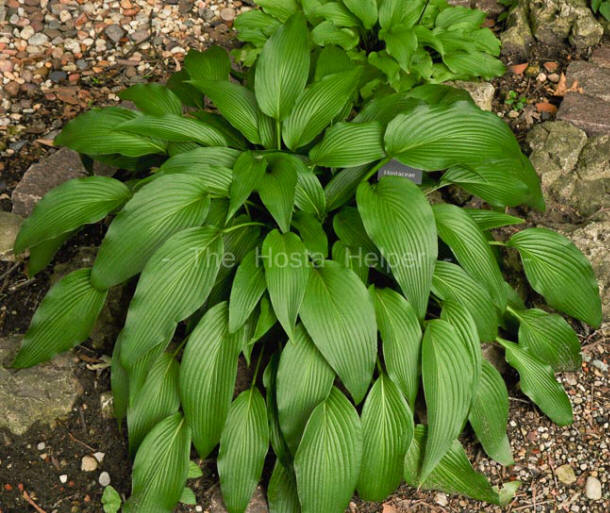



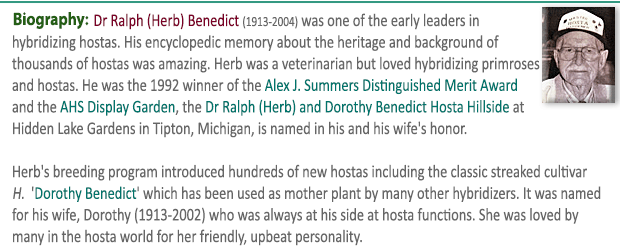
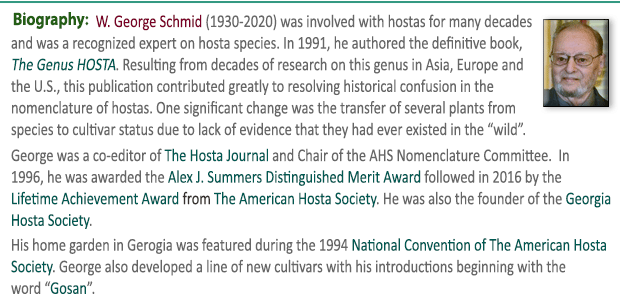

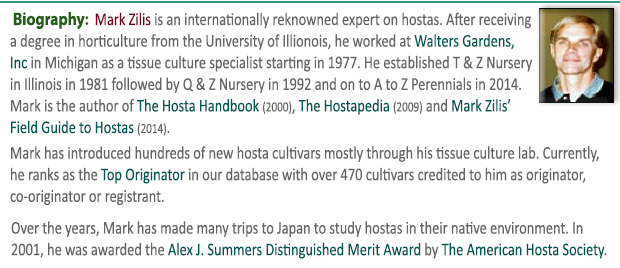
 |
|
 |
 |
 |
 |
 |
 |
 |
 |
 |
 |
 |
 |
 |
|

 |
 |
|
|
|
|



